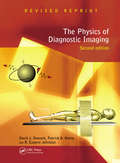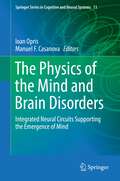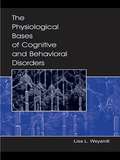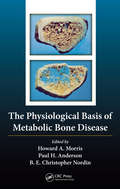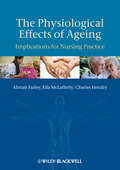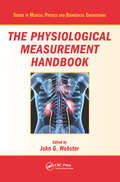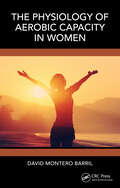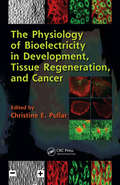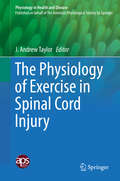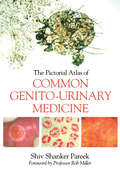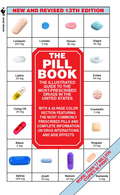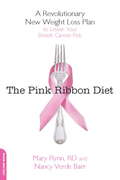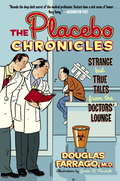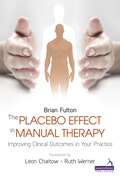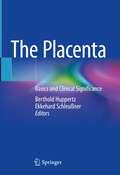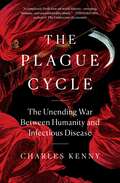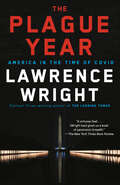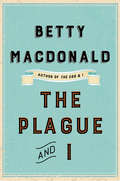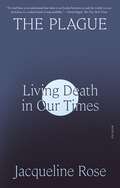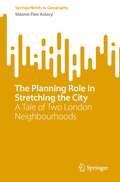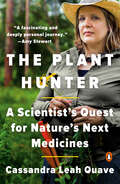- Table View
- List View
The Physics of Diagnostic Imaging
by David Dowsett Patrick A Kenny R Eugene JohnstonOver recent years there has been a vast expansion in the variety of imaging techniques available, and developments in machine specifications continue apace.
The Physics of the Mind and Brain Disorders: Integrated Neural Circuits Supporting the Emergence of Mind (Springer Series in Cognitive and Neural Systems #11)
by Manuel F. Casanova Ioan OprisThis book covers recent advances in theunderstanding of brain structure, function and disorders based on thefundamental principles of physics. Itcovers a broad range of physical phenomena occurring in the brain circuits forperception, cognition, emotion and action, representing the building blocks ofthe mind. It provides novel insightsinto the devastating brain disorders of the mind such as schizophrenia,dementia, autism, aging or addictions, as well as into the new devices for brain repair. The book is aimed at basic researchers inthe fields of neuroscience, physics, biophysics and clinicians in the fields ofneurology, neurosurgery, psychology, psychiatry.
The Physiological Bases of Cognitive and Behavioral Disorders
by Lisa WeyandtUp to twenty percent of the American population suffers from a diagnosable mental disorder, and cross-national studies suggest a high prevalence of such disorders elsewhere. In recent decades, advances in our knowledge of the brain are causing us to question many of the theories underlying traditional approaches to diagnosing and treating these disorders. Researchers in diverse fields--molecular genetics, behavioral, cognitive and clinical neuroscience, neuroimaging, neurophysiology, and neurology--have contributed to the advances.The new knowledge that has been amassed should inform work with clients, but for most practitioners and practitioners-in-training, who lack specialized background, it has been difficult to grasp.In this book, specifically designed to meet the needs of graduate students in clinical, counseling, and school psychology programs, Lisa Weyandt offers a comprehensive, up-to-date, readable overview of our current understanding of the biological bases of psychopathology and its implications for intervention. Early chapters concisely and clearly explain the basics of brain structure and function and current research techniques; they set the stage for chapters examining each major group of disorders. An extensive art program underlines the important points.
The Physiological Basis of Metabolic Bone Disease
by Howard A. Morris Paul H. Anderson B. E. Christopher NordinResearch into metabolic bone disease has made remarkable progress over the last 20 years, with the identification of numerous new molecules and pathways regulating bone cells as well as their plasma milieu. Their activities are largely regulated by the physiological status of the body incorporating the biochemical, physical and mechanical functions
The Physiological Effects of Ageing
by Charles Hendry Alistair Farley Ella McLaffertyThe Physiological Effects of Ageing is a comprehensive resource for all nurses working with older people, enabling them to apply their knowledge of the ageing process to their practice, and, in doing so, enhance care delivery. This book emphasizes the normal ageing changes before considering possible effects of ageing on body systems, using as its framework Roper, Logan and Tierney’s activities of living. Although problems associated with ageing are identified, nursing assessment and interventions are considered which can help reduce the impact these changes have on a person’s functional ability. Special Features: Explores current theories of ageing Makes use of reflective points and points of practice Looks at key topics of maintaining a safe environment and communication Discusses error theory, free radical theory and the immune theory A highly accessible text which encourages holistic patient-centred care
The Physiological Measurement Handbook (Series in Medical Physics and Biomedical Engineering)
by John G. WebsterThe Physiological Measurement Handbook presents an extensive range of topics that encompass the subject of measurement in all departments of medicine. The handbook describes the use of instruments and techniques for practical measurements required in medicine. It covers sensors, techniques, hardware, and software as well as information on processin
The Physiology of Aerobic Capacity in Women
by David Montero BarrilThis book questions the limitation of exercise capacity in women by discussing female physiology from the perspectives of respiratory, circulatory, skeletal, body composition, and training adaptations. Written in a compelling manner, the book covers not only gender differences in exercise physiology but also touches upon such questions as doping and novel mechanisms in exercise theory and practice. Based on first-hand research experience, this book offers new and realistic perspectives, including positive and negative aspects of women’s capacity to perform exercise, which should interest the readers of kinesiology, integrative physiology, clinical science, general science and sociology of sports topics.Key Features: Research-based findings on the cutting-edge topic of women's aerobic capacity Written in an accessible manner and packed with science-based insights Presents an overarching view of various medical disciplines that are essential in evaluating women's aerobic capacity
The Physiology of Bioelectricity in Development, Tissue Regeneration and Cancer (Biological Effects of Electromagnetics)
by Christine E. PullarRecent advances in technology have led to the unprecedented accuracy in measurements of endogenous electric fields around sites of tissue disruption. State-of-the-art molecular approaches demonstrate the role of bioelectricity in the directionality and speed of cell migration, proliferation, apoptosis, differentiation, and orientation. New informat
The Physiology of Exercise in Spinal Cord Injury
by J. Andrew TaylorEvery year, around the world, between 250,000 and 500,000 people suffer a spinal cord injury (SCI). Those with an SCI are two to five times more likely to die prematurely than people without a spinal cord injury, with worse survival rates in low- and middle-income countries. Dynamic aerobic requires integrated physiologic responses across the musculoskeletal, cardiovascular, autonomic, pulmonary, thermoregulatory, and immunologic systems. Moreover, regular aerobic exercise beneficially impacts these same systems, reducing the risk for a range of diseases and maladies. This book will present comprehensive information on the unique physiologic effects of SCI and the potential role of exercise in treating and mitigating these effects. In addition, it will incorporate work from scientists across a number of disciplines and have contributors at multiple levels of investigation and across physiologic systems. Furthermore, SCI can be considered an accelerated form of aging due to the severely restricted physical inactivity imposed, usually at an early age. Therefore, the information presented may have a broader importance to the physiology of aging as it relates to inactivity. Lastly, the need for certain levels of regular aerobic exercise to engender adaptations beneficial to health is not altered by the burden of an SCI. Indeed, the amounts of exercise necessary may be even greater than the able-bodied due to 'passive' ambulation. This book will also address the potential health benefits for those with an SCI that can be realized if a sufficient exercise stimulus is provided.
The Pictorial Atlas of Common Genito-Urinary Medicine (Radcliffe Ser.)
by Shiva PareekSexually transmitted infections remain a global health concern with the World Health Organization reporting over 340 million new cases of bacterial and protozoal STI every year, worldwide. They are frequently associated with a significant degree of medical and psychological morbidity. This full-colour pictorial guide is a unique, single volume compilation of common diseases in genito-urinary medicine. It covers a wide range of ailments from sexually transmitted infections to dermatological conditions affecting the genito-urinary system. Each high-quality image is accompanied by a clear, concise description to aid diagnosis. As well as providing a diagnostic tutorial for trainees in genito-urinary medicine, this book is a reference for any healthcare professional encountering these diseases. Candidates for the Diploma of Genito-urianry Medicine and the Knowledge Based Assessment in Genito-Urinary Medicine will find this visual compendium invaluable.
The Pill Book (14th Edition)
by Harold M. SilvermanTHE CONSUMER'S GUIDE TO PILLS--COMPLETELY REVISED 14th EDITION FOR 2010 WITH MORE THAN 20 IMPORTANT NEW DRUGS AND DOZENS OF NEW BRAND NAMES For more than three decades, millions of consumers have trusted The Pill Book to provide official, FDA-approved information on more than 1,800 of the most commonly prescribed drugs in the United States with guidelines from leading pharmacists. Each drug is profiled in a concise, readable, easy-to-understand entry, making The Pill Book the perfect reference when you have questions about the medications your doctor prescribes. Inside you'll discover * generic and brand-name listings that can help you save money* What each drug is for, and how it works* usual dosages, and what to do if a dose is skipped* side effects and possible adverse reactions, highlighted for quick reference* interactions with other drugs and food* overdose and addiction potential* alcohol-free and sugar-free medications* the most popular self-injected medications and their safe handling* information for seniors, pregnant and breast-feeding women, children, and others with special needs* cautions and warnings, and when to call your doctor* 32 pages of actual-size color photographs of prescription pills* No home should be without this book!*Not all ereading devices will show the images in color and at the exact size.
The Pink Ribbon Diet: A Revolutionary New Weight Loss Plan to Lower Your Breast Cancer Risk
by Rd Nancy Verde Barr Mary FlynnA groundbreaking new diet for the overweight breast cancer patient or anyone at risk for the disease, featuring 150 high-nutrient recipes
The Pioneering Life of Mary Wortley Montagu: Scientist and Feminist
by Jo WillettThe first biography to look at the early feminist and radical Mary Wortley Montagu, who successfully introduced Britain to the inoculation against the smallpox virus.300 years ago, in April 1721, a smallpox epidemic was raging in England. Lady Mary Wortley Montagu knew that she could save her 3-year-old daughter using the process of inoculation. She had witnessed this at first hand in Turkey, while she was living there as the wife of the British ambassador. She also knew that by inoculating - making her daughter the first person protected in the West - she would face opposition from doctors, politicians and clerics. Her courageous action eventually led to the eradication of smallpox and the prevention of millions of deaths. But Mary was more than a scientific campaigner. She mixed with the greatest politicians, writers, artists and thinkers of her day. She was also an important early feminist, writing powerfully and provocatively about the position of women. She was best friends with the poet Alexander Pope. They collaborated on a series of poems, which made her into a household name, an ‘It Girl.' But their friendship turned sour and he used his pen to vilify her publicly. Aristocratic by birth, Mary chose to elope with Edward Wortley Montagu, whom she knew she did not love, so as to avoid being forced into marrying someone else. In middle age, her marriage stale, she fell for someone young enough to be her son - and, unknown to her, bisexual. She set off on a new life with him abroad. When this relationship failed, she stayed on in Europe, narrowly escaping the coercive control of an Italian con man. After twenty-two years abroad, she returned home to London to die. The son-in-law she had dismissed as a young man had meanwhile become Prime Minister.
The Placebo Chronicles: Strange but True Tales From the Doctor's Lounge
by Douglas FarragoTrue Tales of the ridiculous, the silly, and the just plain weird cases doctors face—lampooning the medical bureaucracy that makes practicing medicine and getting medical care such a headache. Doctors have a sick sense of humor. This is the deep, dark, and hilarious secret of the medical profession revealed by the irreverent Dr. Douglas Farrago in his popular satirical magazine,Placebo Journal—affectionately known by its thousands of fanatic readers as “Madmagazine for doctors” and called, byU. S. News. com, “raunchy, adolescent, and very funny. ” Now, inThe Placebo Chronicles, Dr. Farrago has compiled the best of the most outrageous and uproarious true stories to come out of the ERs and examination rooms of doctors all over the country. Submitted by actual physicians, these are the stories they tell each other at cocktail parties and in doctors’ lounges, trading sidesplitting and truly unusual tales of their most embarrassing medical moments, the grossest things they’ve ever seen in medicine, their favorite Munchausen patients, and much more, including “The X-Ray Files”—mind-boggling anecdotes and images of the oddest foreign objects doctors have removed from patients. Not for the faint of heart, the humor inThe Placebo Chroniclesis brutally funny—just what the doctor ordered to guard against the ill effects of an M. D. ’s worst enemies: the Medical Axis of Evil, a. k. a. drug companies, HMOs, and malpractice insurers. Fully illustrated with fake advertisements—for pseudopharmaceuticals like OxyCotton Candy and Indifferex (the mediocre antidepressant)—this refreshingly honest collection invites doctors and patients alike to share the laughter, a liberal dose of the very best medicine.
The Placebo Effect in Manual Therapy: Improving Clinical Outcomes in Your Practice
by Catherine Ryan Diane Lee Louise Tremblay Nancy Keeney Smith Brian FultonNumerous studies have made the 'placebo effect' the most-studied healing phenomenon known to mankind. In The Placebo Effect in Manual Therapy Brian Fulton has drawn on these studies to provide an essential resource for all practitioners who work on a one to one basis with their clients. Those manual therapists who learn from this book will find that their new understanding can lead to improved clinical outcomes for their clients.The Placebo Effect in Manual Therapy presents a knowledge-based approach to augmenting your patients' own healing systems. It explains how to:maximize the placebo response in your patients, using knowledge from 60 years of research"turn on" an individual's inner healing system, even with challenging patientsincrease your success rate and your patients' health outcomes within your current methods of practice
The Placenta
by D. Michael Nelson Yuping Wang Helen KayThe Placenta: From Development to Disease examines research into placental function and its clinical implications to provide a springboard for improving clinical practice and enhancing medical research. Influential information is extracted from the compelling narrative by the use of 'take home' features including: Clinical Pearls - point to important issues in clinical practiceResearch Spotlights - highlight key insights into placental understandingTeaching Points - explain basic concepts for novice readersThe Placenta: From Development to Disease is ideal for both experienced clinicians and researchers and those new to the field. Anyone who needs to understand the central importance of the placenta in the well being of their maternal and fetal patients should read this book.
The Placenta and Human Developmental Programming
by Graham J. Burton David J. P. Barker Ashley Moffett Kent ThornburgDevelopmental programming is a rapidly advancing discipline of great importance to basic scientists and health professionals alike. This text integrates, for the first time, contributions from world experts to explore the role of the placenta in developmental programming. The book considers the materno-fetal supply line, and how perturbations of placental development impact on its functional capacity. Chapters examine ways in which environmental, immunological and vascular insults regulate expression of conventional and imprinted genes, along with their impact on placental shape and size, transport, metabolism and endocrine function. Research in animal models is integrated with human clinical and epidemiological data, and questions for future research are identified. Transcripts of discussions between the authors allow readers to engage with controversial issues. Essential reading for researchers in placental biology and developmental programming, as well as specialists and trainees in the wider field of reproductive medicine.
The Placenta: Basics and Clinical Significance
by Berthold Huppertz Ekkehard SchleußnerThis book is a comprehensive work that spans the gap between basic knowledge and clinical significance of the placenta. Starting from normal development, it deals with the histopathology of the placenta, leads the reader on to functional disorders and insufficiencies and explains their effects on mother and child. Based on this, the authors convey in a practical and user-friendly manner everything worth knowing about diagnostics and therapy and provide valuable information for the optimal care of the pregnant patient.
The Plague Cycle: The Unending War Between Humanity and Infectious Disease
by Charles KennyA vivid, sweeping, and &“fact-filled&” (Booklist, starred review) history of mankind&’s battles with infectious disease that &“contextualizes the COVID-19 pandemic&” (Publishers Weekly)—for readers of the #1 New York Times bestsellers Yuval Harari&’s Sapiens and John Barry&’s The Great Influenza.For four thousand years, the size and vitality of cities, economies, and empires were heavily determined by infection. Striking humanity in waves, the cycle of plagues set the tempo of civilizational growth and decline, since common response to the threat was exclusion—quarantining the sick or keeping them out. But the unprecedented hygiene and medical revolutions of the past two centuries have allowed humanity to free itself from the hold of epidemic cycles—resulting in an urbanized, globalized, and unimaginably wealthy world. However, our development has lately become precarious. Climate and population fluctuations and factors such as global trade have left us more vulnerable than ever to newly emerging plagues. Greater global cooperation toward sustainable health is urgently required—such as the international efforts to manufacture and distribute a COVID-19 vaccine—with millions of lives and trillions of dollars at stake. &“A timely, lucid look at the role of pandemics in history&” (Kirkus Reviews), The Plague Cycle reveals the relationship between civilization, globalization, prosperity, and infectious disease over the past five millennia. It harnesses history, economics, and public health, and charts humanity&’s remarkable progress, providing a fascinating and astute look at the cyclical nature of infectious disease.
The Plague Year: America in the Time of Covid
by Lawrence WrightFrom the Pulitzer Prize–winning author of The Looming Tower: an unprecedented, momentous account of Covid-19—its origins, its wide-ranging repercussions, and the ongoing global fight to contain it From the fateful first moments of the outbreak in China to the storming of the U.S. Capitol to the extraordinary vaccine rollout, Lawrence Wright&’s The Plague Year tells the story of Covid-19 in authoritative, galvanizing detail and with the full drama of events on both a global and intimate scale, illuminating the medical, economic, political, and social ramifications of the pandemic. Wright takes us inside the CDC, where a first round of faulty test kits lost America precious time . . . inside the halls of the White House, where Deputy National Security Adviser Matthew Pottinger&’s early alarm about the virus was met with confounding and drastically costly skepticism . . . into a Covid ward in a Charlottesville hospital, with an idealistic young woman doctor from the town of Little Africa, South Carolina . . . into the precincts of prediction specialists at Goldman Sachs . . . into Broadway&’s darkened theaters and Austin&’s struggling music venues . . . inside the human body, diving deep into the science of how the virus and vaccines function—with an eye-opening detour into the history of vaccination and of the modern anti-vaccination movement. And in this full accounting, Wright makes clear that the medical professionals around the country who&’ve risked their lives to fight the virus reveal and embody an America in all its vulnerability, courage, and potential. In turns steely-eyed, sympathetic, infuriated, unexpectedly comical, and always precise, Lawrence Wright is a formidable guide, slicing through the dense fog of misinformation to give us a 360-degree portrait of the catastrophe we thought we knew as we lived through it.
The Plague and I
by Betty MacDonaldA pre-WW2 American humorist contracts TB and “writes about her seclusion in a way that is painfully, barkingly funny” (Lissa Evans, The Guardian).“Getting tuberculosis in the middle of your life is like starting downtown to do a lot of urgent errands and being hit by a bus. When you regain consciousness you remember nothing about the urgent errands. You can’t even remember where you were going.”Thus begins Betty MacDonald’s memoir of her year in a sanatorium just outside Seattle battling the “White Plague.” MacDonald uses her offbeat humor to make the most of her time in the TB sanatorium—making all of us laugh in the process.“Improbably funny. . . equally remarkable.” ―Steve Donoghue, Open Letters Monthly“Can you imagine writing a whole book about being forbidden to do anything other than lie in bed? But Betty does, and she somehow makes it a riveting chronicle.” ―Lory Widmer Hess, Emerald City Book Review“An appetizing, well-seasoned feast. MacDonald’s sharp, witty observations as she spends almost a year in The Pines Clinic, outside of Seattle, are perfectly pitched . . . with a huge dollop of idiosyncratic humour . . . MacDonald is an impressive and engaging storyteller.” ―Jules Morgan, The Lancet
The Plague and I
by Betty MacdonaldBetty MacDonald had divorced her first husband, (meet him in "The Egg and I," which is available from Bookshare) and had moved back home with her two girls. She was working in an office when the overwhelming fatigue and exhausting cough began. Without much money, she had few choices, which is why she went to The Pines. This biographical book provides us with detailed looks at how tuberculosis was treated during the 1940s and what sanatoriums were like. Other books for adults and children by Betty MacDonald are available from Bookshare.
The Plague: Living Death in Our Times
by Jacqueline RoseA slim, heart-wrenching, and rousing new book from the leading feminist writer Jacqueline Rose.In early 2020, when the COVID-19 pandemic began to infiltrate public consciousness, sales of The Plague, the classic novel by French philosopher Albert Camus, skyrocketed. At the same time, the virus’s toll surged exponentially. Amid the harrowing loss, many sensed a glimmer of possibility—the potential for radical empathy wrought by shared experience—even as the death-dealing divisions of class, race, gender, and citizenship were underscored like never before. We have been through a time of ‘living death’ when, for millions across the globe, untold horror has seemed to infiltrate the very air we breathe.Jacqueline Rose’s trenchant new book unravels recent history via the lives and works of three extraordinary thinkers—Albert Camus, Sigmund Freud, and Simone Weil, each one afflicted by catastrophe. Their politics and private griefs, the depth of their understanding, fling open a window into our present crises. Rose, one of the most insightful thinkers on politics and psychoanalysis alike, has written a story of unusual range, spanning World War II to Russia’s invasion of Ukraine, surging domestic violence to emboldened anti-racist protest, the Spanish influenza to Omicron, Boris Johnson’s deranged optimism to Vladimir Putin’s megalomania. The Plague: Living Death In Our Times enacts a psychic reckoning for our moment and for the future to be forged in its aftermath.
The Planning Role in Stretching the City: A Tale of Two London Neighbourhoods (SpringerBriefs in Geography)
by Shlomit Flint AsheryThis research aims to uncover new insights into minority housing strategies and their impact on densely populated urban areas. The study assumes that as space becomes scarce, inter and intra groups interactions in the urban space motivate people to maximize the utility of the resources at their disposal. This ‘stretch’ of the built environment provides them with critical selective advantages and a sense of security and belonging. Based on two neighbourhoods in London, it contributes to our understanding of housing decisions in the context of illegality and shows the capacity of a given urban form for adaptation: It creates a new semi-private/public space, partly segregated yet deeply integrated; a sphere that, on the one hand, enables traditional ‘nested’ places and, on the other, a fertile environment for integration. This manuscript contributes two new ideas to the knowledge base of residential selections and the geography of opportunities. The first is a detailed analysis of a hyper-segregation/integration pattern resulting from complementary residential strategies operating at the individual unit level. The second is multidimensional stretching, a bottom-up initiation that allows individuals to maximize resources through territorial and spatial practices.
The Plant Hunter: A Scientist's Quest for Nature's Next Medicines
by Cassandra Leah QuaveA leading medical ethnobotanist tells us the story of her quest to develop new ways to fight illness and disease through the healing powers of plants in this uplifting and adventure-filled memoir. Plants are the basis for an array of lifesaving and health-improving medicines we all now take for granted. Ever taken an aspirin? Thank a willow tree for that. What about life-saving medicines for malaria? Some of those are derived from cinchona and wormwood. In today's world of synthetic pharmaceuticals, scientists and laypeople alike have lost this connection to the natural world. But by ignoring the potential of medicinal plants, we are losing out on the opportunity to discover new life-saving medicines needed in the fight against the greatest medical challenge of this century: the rise of the post-antibiotic era. Antibiotic-resistant microbes plague us all. Each year, 700,000 people die due to these untreatable infections; by 2050, 10 million annual deaths are expected unless we act now. No one understands this better than Dr. Cassandra Quave, whose groundbreaking research as a leading medical ethnobotanist--someone who identifies and studies plants that may be able to treat antimicrobial resistance and other threatening illnesses--is helping to provide clues for the next generation of advanced medicines. In The Plant Hunter, Dr. Quave weaves together science, botany, and memoir to tell us the extraordinary story of her own journey. Traveling by canoe, ATV, mule, airboat, and on foot, she has conducted field research in the flooded forests of the remote Amazon, the murky swamps of southern Florida, the rolling hills of central Italy, isolated mountaintops in Albania and Kosovo, and volcanic isles arising out of the Mediterranean—all in search of natural compounds, long-known to traditional healers, that could help save us all from the looming crisis of untreatable superbugs. And as a person born with multiple congenital defects of her skeletal system, she's done it all with just one leg. Filled with grit, tragedy, triumph, awe, and scientific discovery, her story illuminates how the path forward for medical discovery may be found in nature's oldest remedies.
